Magical 3D animation transports you to a happy place
A young boy takes to the snow for an exciting adventure in John Pettingill's beautiful 3D animated short Sleddin'.
Directed by John Pettingill from Texas A&M University, Sleddin' combines the magical intensity of childhood with an adult sense of humour. "I have always been fascinated with memories from my childhood - and just how big they seem in retrospect. Growing up in the mountains of Utah, I would often go sledding. And many of these small hills that I would sled down, I remember feeling like they were massive mountains," says John Pettingill.
The 20-strong team divided their pipeline into assets and shots: within the assets, the artists modelled and rigged using Maya. They referenced the models into a texture file, where they used Slim and Photoshop to build the shaders. They organised the assets into set-dressing.
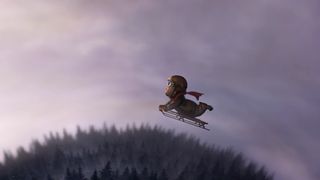
"In the shots directory, we began to reference the set-dressing and started layout and animation in Maya,” says John. "For Sleddin', we wrote a script to convert the animation into .fbx files to prep for effects inside Houdini. Lighting was done in Maya, and effects that needed lighting were exported back to Maya. Rendering was done in Renderman, and we wrapped up with compositing in Nuke and editing in Premiere."
Rendering the snow
Snow is notoriously difficult to get right, and presented Pettingill’s team with their biggest challenge. The FX team, led by Chiang Leng, discovered a workflow using a mixture of particle-based fluids and volume-based fluids in Houdini to create the fine powdery effect.
Leng explains: "After watching several videos of snowboarding and skiing as well as conducting a few tests with fluffy white substances like flour and powdered sugar, we identified two parts of the snow to emulate: the fine powder snow spray that looks like mist/fluid and the solid snow chunks.
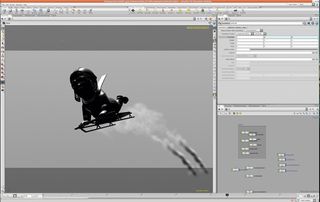
"We decided to use a combination of volumetric fluid and particles in Houdini to achieve the effect. I set up a Houdini network where the sled emits smoke and the points of the terrain that the sled rolls over emits particles, which are then instanced."
This system worked well for the first few shots – because the distance Gus travels in those shots is fairly short – however, in most of the shots Gus is hurtling across ridiculous distances in a very short amount of time. "His average speed in one shot was over 200mph," says Leng.
"The size of the fluid box was just too large and the resolution of the box was too low to look like snow. We also found that since he was travelling so fast, the snow chunks weren’t really reading. We ended up ditching the snow chunks on most of the shots and using a particle-based method for the snow spray. We then applied a ton of blur and colour filters to the particle layer in post to achieve the snow look."
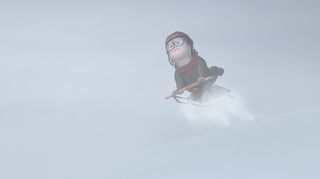
The texture of snow
The snow was the last texture to be done and was also the most difficult to get right. "After we built the script in Slim, we were constantly readjusting parameters depending on the scale of the model and the orientation of the camera." This wasn't ideal, and lighting artist R J Peña was tasked with finding a solution.
"Before the film was integrated into a unified pipeline, shading assets were created individually for the needs of each shot, and although each scene used the same models, the scale of the environments was not relative to one another," explains Peña.
"In particular, this affected the shader for the snow texture, which consisted of many procedural displacement maps layered upon one another. Although the snow may have looked beautiful in one scene, in the next it might look terrible simply due to the fact that the ground plane was scaled to extreme proportions."
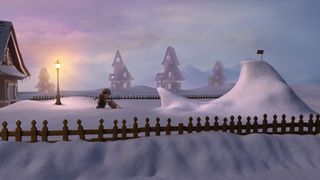
"We had thought that we would be able to adjust the shader in each individual scene to correct the issue, but since Renderman Slim references one project file for all the shading palettes, we were unknowingly changing the shader for every scene each time we adjusted something, which led to a continuous and frustrating cycle of broken snow shaders.
The solution was to duplicate the snow shader within each file so that it would have its own unique palette ID. However, the problem had eaten into their time and the first deadline for Sleddin' (the Siggraph animation festival) was fast approaching when they hit another snag: the last shot was not rendering correctly.
"The frames were either taking too long to get proper iterations for lighting, or they would crash after hours of being on the farm," Pettingill says. "After days and nights of research, we discovered that the shot rendered fine on one of our teammate's accounts, one frame at a time."
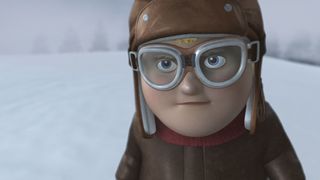
To save time, they locked down the camera, and rendered one frame of each of the environment elements, and then cranked out the animation of the boy running back to the hill. The post-production of this shot was key:
"It was important to the art direction of the film for the snow to contain characteristics from both the beginning sequences - where the snow is darker, bluer and set within a foggy scene - and the later sequences where the sun breaks from behind the clouds and everything glows with rosy light," says R J.
Painting with light
The team used a series of evocative digital 'paintovers' that best captured the mood of the scene, and referred back to those paintings during the lighting process. "Although we would have liked to match those paintings exactly, it isn't always feasible in a 3D space, and in a shot like this one, which was very large and contained duplicates of many complicated assets, we needed to find ways of getting as close to our paintover as we could while still maintaining render times that would allow us to meet our deadlines."

"Since the environment was so complex, we decided to render it completely separate from our moving character, and paint some of the lighting effects into the scene as a matte painting. We ended up with layers that allowed us to manipulate variables separately until we were able to achieve the final look of the shot."
With Nuke and Photoshop, they painted and composited a shot that looked and felt like the rest of the film. "We also managed to finish in four hours of work what we could not finish in two weeks," says R J. "In the end, we submitted to Siggraph 15 minutes before the deadline."
Words: Kulsoom Middleton
Kulsoom Middleton is production editor at 3D World magazine. This article originally appeared in 3D World issue 177.

Thank you for reading 5 articles this month* Join now for unlimited access
Enjoy your first month for just £1 / $1 / €1
*Read 5 free articles per month without a subscription

Join now for unlimited access
Try first month for just £1 / $1 / €1
Get the Creative Bloq Newsletter
Daily design news, reviews, how-tos and more, as picked by the editors.
The Creative Bloq team is made up of a group of design fans, and has changed and evolved since Creative Bloq began back in 2012. The current website team consists of eight full-time members of staff: Editor Georgia Coggan, Deputy Editor Rosie Hilder, Ecommerce Editor Beren Neale, Senior News Editor Daniel Piper, Editor, Digital Art and 3D Ian Dean, Tech Reviews Editor Erlingur Einarsson and Ecommerce Writer Beth Nicholls and Staff Writer Natalie Fear, as well as a roster of freelancers from around the world. The 3D World and ImagineFX magazine teams also pitch in, ensuring that content from 3D World and ImagineFX is represented on Creative Bloq.
